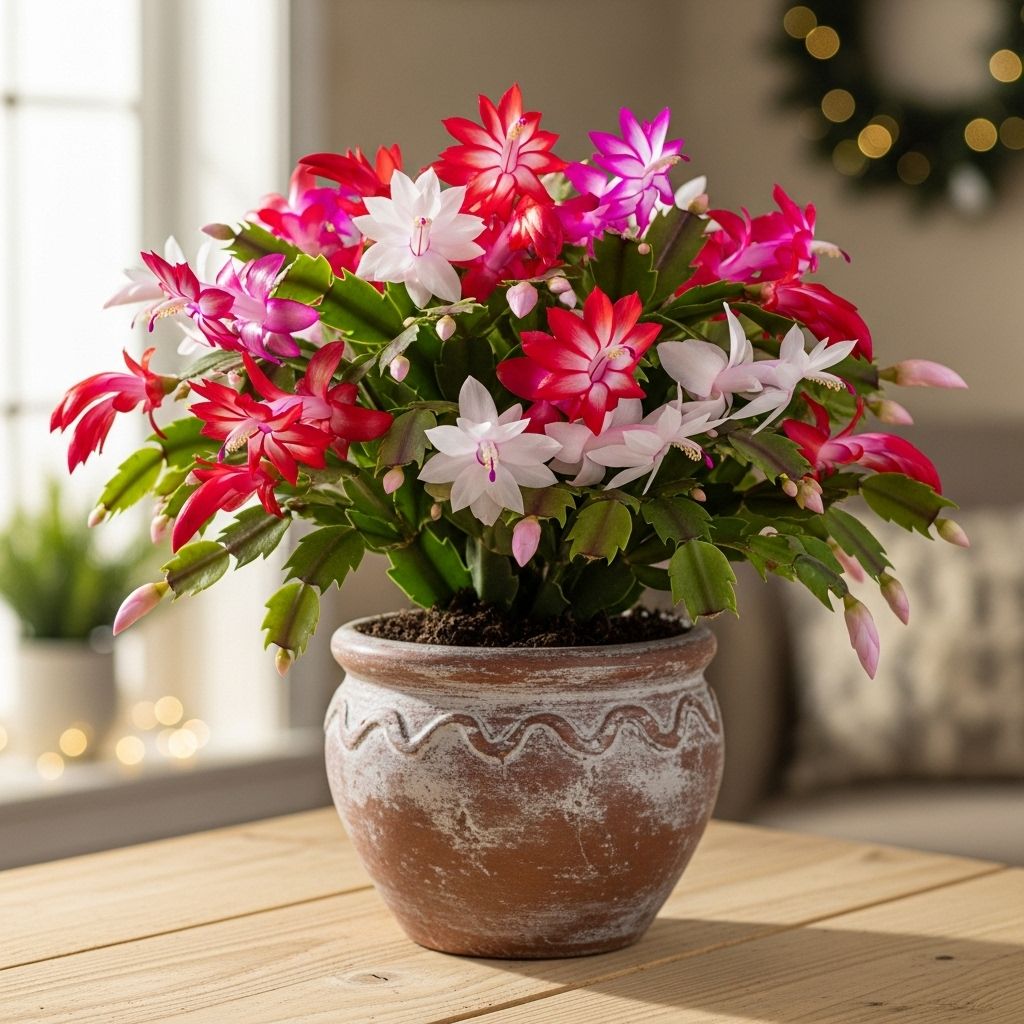Christmas Cactus Care: Comprehensive Guide for Vibrant Blooms
Everything you need to know about growing, caring for, and enjoying the vibrant blooms of the Christmas cactus year after year.

Image: HearthJunction Design Team
Christmas Cactus: The Vibrant Holiday Showstopper
The Christmas cactus (Schlumbergera bridgesii) is a beloved succulent that brings vibrant color to homes during the winter holidays. Unlike its spiny desert relatives, this rainforest native boasts gracefully arching stems and stunning blooms from late fall through winter. With proper care, it can thrive for decades, becoming a cherished family heirloom that bursts into festive color when most gardens have gone quiet.
What Is a Christmas Cactus?
The Christmas cactus is an epiphytic succulent native to the cloud forests of Brazil. It’s prized for its flattened, segmented stems and brilliantly colored flowers that bloom in shades of red, pink, white, and more. Often confused with Thanksgiving and Easter cacti (both Schlumbergera relatives), it’s known for reliable wintertime blooms, cascading growth, and, with the right touch, easy year-round care.
- Common Names: Christmas cactus, holiday cactus, winter cactus, crab cactus
- Botanical Name: Schlumbergera bridgesii
- Origin: Cloud forests of Brazil
- Flowering Season: Late November to January (with proper care and conditions)
Christmas Cactus vs. Thanksgiving and Easter Cactus
| Feature | Christmas Cactus (Schlumbergera bridgesii) | Thanksgiving Cactus (S. truncata) | Easter Cactus (Hatiora gaertneri) |
|---|---|---|---|
| Bloom Time | December-January | November-December | March-April |
| Stem Edges | Rounded, scalloped | Pointed, toothed | Bristeled, rounded |
| Flower Shape | Drooping, tube-like | More upright, claw-like | Star-shaped |
While all three are widely grown as houseplants, it’s the Christmas cactus—distinguished by its scalloped, drooping stems and winter bloom—that is most associated with holiday tradition.
Caring for Your Christmas Cactus
Light Requirements
- Bright, indirect sunlight is ideal. Too much direct sun can cause stems to yellow or burn.
- East- or north-facing windows are perfect. Avoid harsh afternoon exposure.
- During winter, supplement with fluorescent lights if natural light is limited.
Temperature & Humidity
- Prefers daytime temperatures between 60–70°F (15–21°C).
- Nighttime temps can drop to around 50–55°F (10–13°C) in the fall to initiate bud formation.
- Protect from sudden drafts and temperature swings.
- Enjoys moderate to high humidity. Place on a pebble tray or group with other plants for extra moisture.
Watering
- Keep soil slightly moist but not soggy during active growth and blooming.
- Allow the top inch of soil to dry before watering again—check weekly.
- Reduce watering during dormancy (post-bloom until new growth begins).
- Water less in winter than in summer; overwatering can lead to root rot.
Soil & Potting
- Use a well-draining potting mix, such as a specialized cactus or succulent blend with extra perlite or sand.
- Christmas cacti bloom best slightly pot-bound. Repot every 2-3 years, in spring or early summer after flowering.
- Ensure pots have drainage holes to prevent excess moisture accumulation.
Fertilizing
- Feed monthly during the active growth season (spring and summer) with a half-strength, water-soluble fertilizer.
- Withhold fertilizer during the fall and winter bloom period.
- Too much fertilizer can inhibit flowering and promote leaf growth at the expense of blooms.
Encouraging Christmas Cactus to Bloom
The highlight of owning a Christmas cactus is the dazzling display of blooms during the holidays. However, getting your plant to rebloom takes a bit of planning and the right conditions:
- Cool Temperatures: Provide 6–8 weeks of cooler nights (50–55°F) in the fall to trigger bud formation.
- Correct Light/Dark Schedule: 12–14 hours of darkness each night for at least 6 weeks encourages flower bud set.
- Limit Watering: Reduce watering frequency slightly in the fall until buds appear, then resume regular care.
- Avoid Moving the Plant: Once buds develop, sudden changes in temperature, location, or drafts can cause them to drop.
Yearly Care Schedule for Christmas Cactus
- Spring: After flowering, lightly prune if needed and begin regular fertilizer applications.
- Summer: Move outdoors to a shaded spot if desired; water and fertilize as the plant grows.
- Late Summer/Fall: Move indoors before frost. Decrease watering and stop fertilizing to help trigger budding as days shorten.
- Winter: Provide cool nights and four to six hours of bright, indirect sunlight daily. Keep humidity high to support blooms.
Propagation: How to Grow More Christmas Cactus
Sharing Christmas cactus with friends and family is easy, as the plant responds well to simple propagation techniques:
- Take Cuttings: Snip 2–4 segment stem sections after the plant has finished blooming (spring is best).
- Allow to Callus: Let your cuttings dry for a day or two to prevent rot.
- Plant in Soil: Insert cuttings into moistened cactus soil. Keep lightly moist in a warm, bright location (out of direct sunlight).
- Rooting: Roots should form in about 3–4 weeks. Move to a small pot and resume regular care.
Common Problems and Solutions
- Buds Dropping: Usually caused by sudden temperature changes, drafts, inconsistent watering, or moving the plant.
- Wilted or Limp Leaves: Indicates either overwatering (roots rotted) or underwatering (dried out soil). Adjust watering accordingly.
- No Flowers: Check for insufficient cool period, inadequate light/dark cycles, or excessive fertilizer.
- Pest Issues: Christmas cactus is generally pest-free, but mealybugs or spider mites can occasionally appear. Treat with insecticidal soap if needed.
Popular Christmas Cactus Varieties
- ‘White Christmas’: Pure white blooms brighten winter windowsills.
- ‘Dark Marie’: Violet-magenta flowers with a ruffled appearance.
- ‘Thor Alex’: Luxuriant, deep pink blossoms.
- ‘Christmas Flame’: Striking orange-yellow blooms for a unique twist.
Decorating with Christmas Cactus
- Showcase as a centerpiece during the holidays.
- Hang in baskets to emphasize cascading stems and abundant flowers.
- Pair with other winter bloomers like amaryllis or poinsettia for a festive display.
- Gift cuttings or mature plants to loved ones as a living holiday tradition.
Frequently Asked Questions (FAQs)
How long will my Christmas cactus live?
With proper care, Christmas cacti can live for decades—and are often passed down through generations as treasured houseplants.
Why isn’t my Christmas cactus blooming?
Common culprits include insufficient dark periods, lack of cool nights, over-fertilization, or abrupt environmental changes during bud set.
Is the Christmas cactus poisonous to pets?
No, Christmas cactus (Schlumbergera) is considered non-toxic to cats and dogs. However, ingesting any houseplant may still cause mild digestive upset.
How often should I repot my Christmas cactus?
Repotting is only needed every 2–3 years or when roots fill the pot. They often bloom best when slightly pot-bound.
Can I place my Christmas cactus outdoors?
Yes—move it outside to a shady, protected spot during the warm months, but be sure to bring it in before temperatures drop below 50°F (10°C).
In Summary: The Joy of Growing Christmas Cactus
With minimal effort, the Christmas cactus offers a dazzling winter display, easy propagation, and years of beauty. By following these simple care tips—providing indirect light, keeping the right temperature and humidity, watering carefully, and ensuring a proper blooming regimen—you can enjoy this festive plant year after year. Whether you’re a seasoned plant enthusiast or a beginner, the Christmas cactus remains a rewarding and resilient addition to any home or holiday tradition.
References
Read full bio of Shinta












